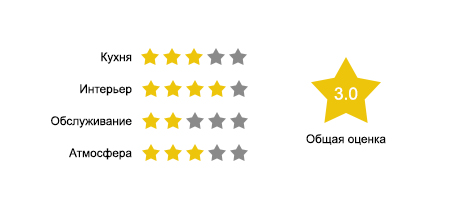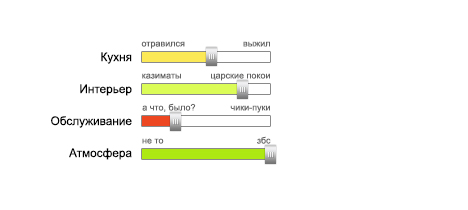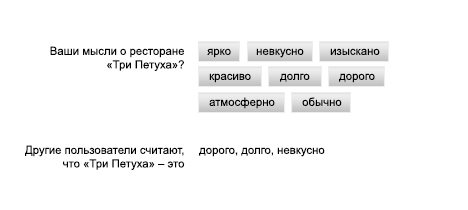User Rating Thoughts
In many cases, we’re used to clicking “like” or “dislike” to evaluate something on the Internet. The most obvious examples are social networks. But sometimes dividing into likes and dislikes is simply not enough for a more accurate rating system.
Take, for example, the task of users evaluating a new restaurant that has recently appeared in the city. This problem is usually solved by a "school" scale of 5 points. It can be stars or more and more emoticons with different emotions. It works simply, quickly and conveniently. But, as usual, it cannot do without a “but”. Putting your rating, the user describes the overall impression of the restaurant. This is an extensive assessment, which implies the totality of everything: cuisine, interior, music, service, etc. And what, in essence, does the first and fifth stars in such a ranking mean? The first is worse than in the cheapest tavern, and the fifth is the level of the best European institutions? No one answers these questions, and such a rating adapts to the user's perception, which, by the way, is a very interesting phenomenon (but let's not talk about that).

For me, a scale of 5 points narrows to 2.5. We have to make extra efforts to be objective. Conclusion: like “likes”, such a system copes with its tasks, but it is not suitable for a detailed “debriefing”.
It is worth raising the question of objective evaluations in advance. Public morality teaches us to soften our minds. It’s easier to say “Your restaurant is not as good as it could be” than “This is the worst place in the whole universe.” Even though the web is not a one-on-one communication, we are faced with the same standards as in the real world. Some deliberately overstate so as not to offend. Well, it happens that they underestimate.
I will try to formulate a new problem. Suppose the management of a new restaurant wants to improve the quality of service and understand what visitors like or dislike in their restaurant. They want an honest feedback to improve or change something.
In this case, a reasonable decision would be to divide the assessment into parameters: kitchen, interior, service, atmosphere. This will provide an opportunity to understand in which area the most problems. We will do so, but here we are waiting for the “plug”.

We do not want to leave the usual, well, okay. So much better already. We often saw this, for example, in Skype when evaluating the quality of communication. But again, we give the user to reflect on the meaning of stars. But it works like this: every time, moving on to the next assessment, we subconsciously create our own scale with our own values (bad - good, tasty - tasteless, beautiful - ugly). This causes additional difficulties when the estimated parameters belong to different fields (music and service). And if there are a lot of such parameters, then the difficulties turn into user discontent.

In this form, it does not matter what is used: sliders or asterisks. The bottom line is that the extreme values represent the support of the scale. This helps to understand what the worst and best score means. Now our 1 and 5 begin to work when the user agrees with the extreme values. He does not waste time creating his own rating scale and this is a plus. However, the success of such a rating directly depends on how accurately the extreme values are suitable for determining the entities being evaluated, which is sometimes difficult to imagine. So in one restaurant, the chef's goal may be the sophistication of dishes and their presentation, and in another, taste and price.

Pretty unusual solution. We again came to the conclusion that instead of four parameters we have one, but composite. This decision is somewhat reminiscent of a psychological test, the result of which will be answers to questions that a person can ask himself. A quick reading of the keywords, the user will focus on what he considers the most suitable. At the same time, we do not show exactly what kind of rating each word carries. This helps to avoid user doubt when categorizing (very bad and very good). In theory (I admit honestly, in practice I have not seen such a thing before) such a rating system can give very plausible results. Another plus - imitates a more “human” user interaction with the site. And the same “human” characteristic as a result. No need to leaf through the comments to understand what people think about the establishment. According to this characteristic, restaurant owners will be able to understand what users do not like and whether their positioning matches reality.

The disadvantages of this decision can be easily attributed to what you need to read, that it can be cumbersome and unusual. And of course, that such a rating needs to be tested. However, the concept seems to me very similar to the right path.
Each assessment system has its own tasks and its own field of application. The choice from an infinite number of possible solutions depends only on your goals. But still, the question of a convenient and universal tool for rating a large number of heterogeneous parameters is open to me (I think not for me alone). And he is interesting enough to express his thoughts.
Take, for example, the task of users evaluating a new restaurant that has recently appeared in the city. This problem is usually solved by a "school" scale of 5 points. It can be stars or more and more emoticons with different emotions. It works simply, quickly and conveniently. But, as usual, it cannot do without a “but”. Putting your rating, the user describes the overall impression of the restaurant. This is an extensive assessment, which implies the totality of everything: cuisine, interior, music, service, etc. And what, in essence, does the first and fifth stars in such a ranking mean? The first is worse than in the cheapest tavern, and the fifth is the level of the best European institutions? No one answers these questions, and such a rating adapts to the user's perception, which, by the way, is a very interesting phenomenon (but let's not talk about that).

For me, a scale of 5 points narrows to 2.5. We have to make extra efforts to be objective. Conclusion: like “likes”, such a system copes with its tasks, but it is not suitable for a detailed “debriefing”.
Facts about a person
It is worth raising the question of objective evaluations in advance. Public morality teaches us to soften our minds. It’s easier to say “Your restaurant is not as good as it could be” than “This is the worst place in the whole universe.” Even though the web is not a one-on-one communication, we are faced with the same standards as in the real world. Some deliberately overstate so as not to offend. Well, it happens that they underestimate.
Where problems begin
I will try to formulate a new problem. Suppose the management of a new restaurant wants to improve the quality of service and understand what visitors like or dislike in their restaurant. They want an honest feedback to improve or change something.
In this case, a reasonable decision would be to divide the assessment into parameters: kitchen, interior, service, atmosphere. This will provide an opportunity to understand in which area the most problems. We will do so, but here we are waiting for the “plug”.
Option 1. I like how it was

We do not want to leave the usual, well, okay. So much better already. We often saw this, for example, in Skype when evaluating the quality of communication. But again, we give the user to reflect on the meaning of stars. But it works like this: every time, moving on to the next assessment, we subconsciously create our own scale with our own values (bad - good, tasty - tasteless, beautiful - ugly). This causes additional difficulties when the estimated parameters belong to different fields (music and service). And if there are a lot of such parameters, then the difficulties turn into user discontent.
Option 2. More specifically

In this form, it does not matter what is used: sliders or asterisks. The bottom line is that the extreme values represent the support of the scale. This helps to understand what the worst and best score means. Now our 1 and 5 begin to work when the user agrees with the extreme values. He does not waste time creating his own rating scale and this is a plus. However, the success of such a rating directly depends on how accurately the extreme values are suitable for determining the entities being evaluated, which is sometimes difficult to imagine. So in one restaurant, the chef's goal may be the sophistication of dishes and their presentation, and in another, taste and price.
Option 3. Tag cloud?

Pretty unusual solution. We again came to the conclusion that instead of four parameters we have one, but composite. This decision is somewhat reminiscent of a psychological test, the result of which will be answers to questions that a person can ask himself. A quick reading of the keywords, the user will focus on what he considers the most suitable. At the same time, we do not show exactly what kind of rating each word carries. This helps to avoid user doubt when categorizing (very bad and very good). In theory (I admit honestly, in practice I have not seen such a thing before) such a rating system can give very plausible results. Another plus - imitates a more “human” user interaction with the site. And the same “human” characteristic as a result. No need to leaf through the comments to understand what people think about the establishment. According to this characteristic, restaurant owners will be able to understand what users do not like and whether their positioning matches reality.

The disadvantages of this decision can be easily attributed to what you need to read, that it can be cumbersome and unusual. And of course, that such a rating needs to be tested. However, the concept seems to me very similar to the right path.
Conclusion
Each assessment system has its own tasks and its own field of application. The choice from an infinite number of possible solutions depends only on your goals. But still, the question of a convenient and universal tool for rating a large number of heterogeneous parameters is open to me (I think not for me alone). And he is interesting enough to express his thoughts.
